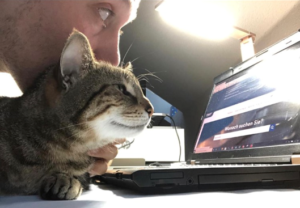Michael Baumann is SKF’s business development manager for marine and ocean energy
My role on the EnFAIT is to lead each of the SKF teams that are responsible for project deliverables. Work Package 9, which is executed by SKF BV focusses on optimising the tidal array’s reliability and maintainability. These tasks are crucial to the over-arching goal of reducing the cost of tidal energy by 40 per cent, paving the way for a commercial tidal energy sector in Europe.
For me personally, the project has also been an opportunity to reconnect with the ocean energy scene in Scotland. While I now live close to Schweinfurt, Germany, I studied at Edinburgh’s Heriot-Watt University for my MSc in Energy and worked in Scotland for over seven years, leading SKF’s involvement in the country’s emergent ocean energy sector.

During the first months of the project (in H2 2017), I returned to Scotland for the first stage of our work: conducting a forensic analysis of all systems and components of Nova Innovation’s M100 turbine, which had been in operation at Shetland for two years. My team at SKF then produced scenarios for potential array failures to ensure that failure causes and effects were fully considered when designing the turbines. Our findings can be found in the public report Tidal Array Design Failure Mode Effects Analysis (DFMEA).
Another task for these early months was to create models for optimum life-cycle cost management of the Shetland Tidal Array. By applying a Reliability, Availability and Maintainability (RAM) approach, we were able to provide an integrated analysis of expected system performance. And using SKF’s Asset Management Support Tool (AMST), we were also able to review the maintenance schedule for the turbines and create an optimised schedule aiming to deliver tangible cost benefit.
That was just the start of our work on this epic tidal energy journey. The SKF team continues work on two of the project’s core challenges.
- Delivery of a Tidal Array Condition Monitoring System (CMS). This means assembling, testing and commissioning an online CMS based upon proven technologies used by SKF in other offshore sectors. We have outlined the sensors that should be integrated into each turbine nacelle and drivetrain, ensuring early warning of potential failures and timely interventions. There are two parts to the deployment here: retrofitting the turbines that pre-existed the project and installing the CMS to new turbines as they are deployed to the array.
- Array Condition Monitoring Data Analysis. SKF is also providing a Remote Diagnostic Centre (RdC) service from our DNV-GL certified operation based in Aberdeen. We continue to collaborate with Nova Innovation to develop an Integrated Operations Control Centre (IOCC), mirroring the recent developments in other offshore sectors, ensuring that technicians can stay ashore for these tasks. Part of the challenge is creating a tool that can automate the diagnosis of the large volumes of data coming from the turbines and ensuring the severity of faults is accurately represented (based upon our historic condition monitoring results). We are also using forensic and Root Cause Failure Analysis (RCFA) to determine complete array component wear rate, lifetimes, service intervals and operational costs.
Throughout the project, we are drawing together a precious bank of learnings about tidal turbine reliability and maintenance too. These feed into the operation and maintenance strategy for reducing costs at the EnFAIT project site and will be made available to interested public bodies and the wider ocean energy industry. In this way, each step that we take on EnFAIT will help to fuel work by other developers in Europe and accelerate our young industry across the continent.

